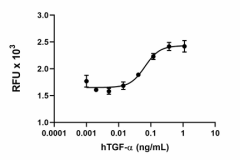- Regulatory Status
- RUO
- Other Names
- TGFA

-

Recombinant human TGF-α induces the proliferation of BALB/3T3 cells in a dose-dependent manner. The ED50 = 0.02 - 0.1 ng/mL.
| Cat # | Size | Price | Quantity Check Availability | ||
|---|---|---|---|---|---|
| 589902 | 10 µg | $59.00 | |||
| 589904 | 25 µg | $101.00 | |||
| 589906 | 100 µg | $223.00 | |||
Select size of product is eligible for a 40% discount! Promotion valid until December 31, 2024. Exclusions apply. To view full promotion terms and conditions or to contact your local BioLegend representative to receive a quote, visit our webpage.
TGF-α was initially identified in the culture medium of several transformed cell lines. TGF-α is structurally and functionally related to the epidermal growth factor and belongs to the EGF subfamily that also includes amphiregulin (AR), heparin binding EGF-like growth factor (HB-EGF), betacellulin (BTC), epiregulin (EPR), and epigen (EPG). TGF-α is derived from a transmembrane precursor (20-22 kD); pro-TGFα undergoes several posttranslational modifications that include N- and O-linked glycosylation and palmitoylation. The pro-TGFα includes a glycosylated N-terminal domain, a TGF-α region with the EGF-like motif, a linker sequence that joins the ectodomain to the transmembrane domain, and an intracellular portion. TGF-α is proteolytically released from the membrane by tumor necrosis factor-α converting enzyme (TACE/ADAM-17). TGF-α is cleaved at the N- and C-terminus of the EGF motif; the proteolytic cleavage at the C-terminus is required to release the soluble form. The N-terminal cleavage of pro-TGFα occurs at the cell surface by TACE-independent activity. TGF-α plays a key role regulating follicle development and tumorigenesis. TGF-α and its receptor are highly expressed in papillary thyroid carcinoma. Also, TGF-α polymorphism has been associated with oral birth defects.
Product Details
- Source
- Human TGF-α, amino acids (Val40-Ala89) (Accession# NM_003236) was expressed in E.coli.
- Molecular Mass
- The 50 amino acid recombinant protein has a predicted molecular mass of approximately 5.5 kD. The DTT-reduced and non-reduced protein migrate at approximately 8 and 6 kD by SDS-PAGE respectively. The N-terminal amino acid is Val.
- Purity
- >98%, as determined by Coomassie stained SDS-PAGE.
- Formulation
- 0.22 µm filtered protein solution is in PBS.
- Endotoxin Level
- Less than 0.01 ng per µg cytokine as determined by the LAL method.
- Concentration
- 10 and 25 µg sizes are bottled at 200 µg/mL. 100 µg size and larger sizes are lot-specific and bottled at the concentration indicated on the vial. To obtain lot-specific concentration and expiration, please enter the lot number in our Certificate of Analysis online tool.
- Storage & Handling
- Unopened vial can be stored between 2°C and 8°C for up to 2 weeks, at -20°C for up to six months, or at -70°C or colder until the expiration date. For maximum results, quick spin vial prior to opening. The protein can be aliquoted and stored at -20°C or colder. Stock solutions can also be prepared at 50 - 100 µg/mL in appropriate sterile buffer, carrier protein such as 0.2 - 1% BSA or HSA can be added when preparing the stock solution. Aliquots can be stored between 2°C and 8°C for up to one week and stored at -20°C or colder for up to 3 months. Avoid repeated freeze/thaw cycles.
- Activity
- Recombinant human TGF-α induces the proliferation of BALB/3T3 in a dose-dependent manner. The ED50 = 0.02 - 0.1 ng/mL.
- Application
-
Bioassay
- Application Notes
-
BioLegend carrier-free recombinant proteins provided in liquid format are shipped on blue-ice. Our comparison testing data indicates that when handled and stored as recommended, the liquid format has equal or better stability and shelf-life compared to commercially available lyophilized proteins after reconstitution. Our liquid proteins are verified in-house to maintain activity after shipping on blue ice and are backed by our 100% satisfaction guarantee. If you have any concerns, contact us at tech@biolegend.com.
- Product Citations
-
Antigen Details
- Distribution
-
Expressed by many human tumors, human granulosa cells, theca cells, keratinocytes, and a number of epithelial cells
- Function
- TGF-α has angiogenic properties. It is a potent mitogen, and it induces KGN (human granulosa cell tumor) cell proliferation, cell viability, cell cycle progression, and cell migration. Also, it induces cell proliferation and differentiation in epithelial and neuronal cells.
- Interaction
- Human granulosa cells, epithelial cells
- Ligand/Receptor
- EGFR
- Cell Type
- Embryonic Stem Cells, Hematopoietic stem and progenitors, Mesenchymal Stem Cells, Neural Stem Cells
- Biology Area
- Cell Biology, Signal Transduction, Stem Cells
- Molecular Family
- Cytokines/Chemokines, Growth Factors
- Antigen References
-
1. Derynck R, et al. 1984. Cell 38:287.
2. Sunnarborg SW, et al. 2002. J. Biol. Chem. 277:12838.
3. Juanes PP, et al. 2005. Biochem. J. 389:161.
4. Sull JW, et al. 2009. Hum. Genet. 126:385.
5. Degl’Innocenti D, et al. 2010. PLoS One 5:e12701.
6. Wang C, et al. 2012. PLoS One 7:e48299. - Gene ID
- 7039 View all products for this Gene ID
- UniProt
- View information about TGF-alpha on UniProt.org
